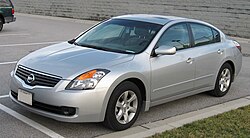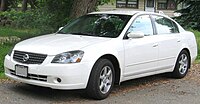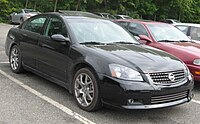| Nissan Altima | |
|---|---|
 | |
| Manufacturer | Nissan |
| Production | 1993–present |
| Predecessor | Nissan Stanza |
| Class | Compact (1993-2001) Mid-size (2002-present) |
| Layout | FF layout |
The Altima (pronounced ALL-teemah) is a mid-size car (formerly compact) currently being manufactured by the Japanese automaker Nissan, and is arguably a continuation of the "bloodline" that began with the Nissan Bluebird in 1957. It has historically been larger, more powerful, and more luxurious than the Nissan Sentra but less so than the Nissan Maxima. It competes with the Mazda 6, Honda Accord, Toyota Camry, Subaru Legacy, Mitsubishi Galant, Hyundai Sonata, Volkswagen Passat, and Ford Fusion.
In addition to North America, the Altima is available in the Middle East. In other markets, Nissan sells a related mid-size sedan called the Nissan Teana, built on the same FF-L platform.
History
The Altima name was originally a trim line of the Nissan Laurel mid-size car sold in the Caribbean before 1992. In 1993, Nissan discontinued its much-criticized Stanza, replacing it with the US-made Altima, while remaining a compact car. The very first Altima rolled off the assembly line on June 15, 1992 as a 1993 model. All Altimas had been built in Smyrna, Tennessee until June 2004, when Nissan's Canton, Mississippi, plant began producing additional Altimas to meet high demand.
The Altima has had four design generations: 1993-1997, 1998-2001, 2002-2006, and 2007-present.
First generation (1993-1997)
| First generation | |
|---|---|
 | |
| Also called | Nissan Stanza Altima |
| Production | 1993–1997 |
| Assembly | Smyrna, Tennessee |
| Body style(s) | 4-door sedan |
| Engine(s) | 2.4 L KA24DE I4 150 hp (112 kW) |
| Transmission(s) | 5-speed manual 4-speed automatic |
| Wheelbase | 103.1 in (2619 mm) |
| Length | 180.5 in (4585 mm) |
| Width | 67.1 in (1704 mm) |
| Height | 55.9 in (1420 mm) |
| Related | Nissan Bluebird |
Like the Stanza before it, the original Altima was based on the Nissan Bluebird SSS (Chassis Model U13), though its original styling hailed from Nissan's California design studio. Initially, the car's official name was "Stanza Altima," which appears on the early owners manuals. 1993 models can be seen with a sticker reading "Stanza" in small lettering to the left of the ALTIMA emblem on the trunk lid.
All Altima models used Nissan's 150 horsepower (112 kW) KA24DE I4 DOHC engine mated to a 5-speed manual or 4-speed automatic, which provided the fastest performance among all 4-cylinder competitors (8.7 seconds to 60 mph (100 km/h) with automatic). (By contrast, the Japanese Bluebird SSS could be had with Nissan's famous SR20DET engine and all-wheel-drive.) Suspension was composed of struts with stabilizer bars at both ends and was noted for providing sporty, satisfying handling (plus a firm ride and moderate road noise); all wheels were 15-inches. Being one of the bigger compact cars, the Altima could seat four adults fairly comfortably, though its body was too skinny for five. Trim lines consisted of the stripper XE, mid-line GXE, sporty SE, and luxury GLE. Some options included a gold emblem package, molded mud guards, and a pin stripe. All 1993 and 1994 models came with a chrome exhaust tip standard; it was removed in 1995 when the Altima was cheapened up. All Altima models had a very small glovebox and the cupholders were in a poor location under the radio.
The base XE (rare) had manual windows. The mid-line GXE had power windows, a power retracting antenna, pass thru rear armrest, digital clock in dash, and color matched plastic speaker grills for the rear 6 inch speakers. The XE and GXE models only had the fixed intermittent wiper switch.
In addition to the GXE features, the SE had a stiffer suspension, fog lights, 3 leg mount rear spoiler (1993 models with a clear LED brake light), side skirts (no upper side moldings), and sport seats (plus a standard sunroof in 1994-1995). It also had 4-wheel disc brakes, which came on the other trim lines when antilock brakes were ordered.
The GLE's enhancements included a digital heads-up display(1993 and 1994 only), which displayed speed in MPH or km/h, turn signals, and various warning lights on a unique mirrored patch made into the windshield. The 1989 to 1994 Maxima and 240SX had similar technology but only showed speed. Other features included a coin holder built into the fuse panel cover(1993 and 1994 only), adjustable lumbar support on the front seats, automatic digital climate control, keyless entry with alarm(optional), floor mats, color matched side mirrors, cornering lights, sunroof, and a higher-powered six-speaker cassette/CD stereo which included 6X9 rear speakers with black metal "active speaker" grills, metal color matched "active speaker" grills for the front door speakers(1993 and 1994 only), and a pair of A pillar tweeters all powered by 2 factory amps mounted underneath the rear deck. For 1997 it gave up all of the above in exchange for standard leather (previously optional). All SE and GLE models had alloy wheels and variable intermittent wipers.
1993 Altimas came with a rosewood colored dash trim and only had a driver's side airbag coupled with automatic shoulder belts(the center console was slimmer to accommodate the lap belts). The 1994 Altima gained a darker burl wood dash trim, a flush mount passenger airbag and normal seatbelts, though it lost its optional limited-slip differential. 1993 and 1994 models came with chrome inner door handles standard with an auto door lock/unlock feature on the passenger side, in 1995, the inner door handles were changed to color matched plastic and a plug replaced where the passenger auto door lock/unlock feature was. 1993 and 1994 models also had a slim 1½ armrest lid, however, if leather was selected on the GLE a leather cover brought the height up to about 4½ inches. In 1995, all the armrest lids were thicker and about 4½ inches tall. 1995 also brought a new venetian blind-like grille, new taillights (red and clear), and a new 2 leg mount spoiler with a red LED brake light for the SE. Some other changes included the removal of the rear speaker grills for a flat rear deck, a cheaper cloth interior, a raised mount passenger airbag, a plastic cover replacing the rear ashtray, and the digital in dash clock was now optional. 1996 brought new wheel covers for base models. In 1997 the GXE gained a new "Limited Edition" package including alloy wheels, keyless entry, alarm, floor mats, and a Limited Edition sticker on each side near the front wheels. The majority of final-year Altima models were dubbed "1997.5" models, signifying the added crash protection necessary to meet 1997 side-impact standards.
Second generation (1998-2001)
| Second generation | |
|---|---|
 | |
| Production | 1998–2001 |
| Assembly | Smyrna, Tennessee |
| Body style(s) | 4-door sedan |
| Engine(s) | 2.4 L KA24DE I4 |
| Transmission(s) | 5-speed manual 4-speed automatic |
| Wheelbase | 103.1 in (2619 mm) |
| Length | 185.8 in (4719 mm) (2000-01) 183.5 in (4661 mm) (1998-99) |
| Width | 69.1 in (1755 mm) |
| Height | 55.9 in (1420 mm) |
The second generation (codenamed L30) was an American market-only version, again styled by Nissan's California design center. Most of its mechanicals came from the previous Altima, though the body was slightly larger and reportedly 20% stiffer, and the tracks were widened. A new interior brought a better glovebox and cupholders, a folding back seat (except on XE), and depowered airbags. While total volume remained identical at 108 cubic feet, most felt it was distributed better and resulted in a slightly roomier-feeling cabin. On the downside, many were let down by the new model's plainer styling and cheapened interior; some also felt the gas pedal was now too lightly sprung.
Trim lines were GXE, SE, and GLE. The SE can be distinguished by its body-color grille, fog lights, rear spoiler, alloy wheels, and white-faced gauges. In this generation of Altima, all GLEs had leather seats standard.
For 1999 the uplevel cassette/CD stereo got a new faceplate and better sound quality, GXE and SE models gained variable intermittent wipers, and GLEs gained standard alloy wheels.
The majority of changes came for 2000. The engine was upgraded from 150 to 155 hp (116 kW), gearing and final drive ratios were shortened on both transmissions, stabilizer bars were thickened, and the steering was firmed up. SE and GLE models also upgraded to 16-inch wheels with lower-profile tires, new Monroe struts with "acceleration-sensitive strut valving", and a front strut tower brace for sportier handling (all optional on GXE). The Altima grew slightly longer and got a deeper front grille, one-piece headlamps with turn signals, all-red taillights, and plastic trim on the decklid. Inside were new front seats with a driver's height adjuster, cupholders for the rear seat, revised seat cloth, a new instrument panel with digital odometers, a new rear window antenna, and the keyless entry fob now included a trunk release. Side airbags were newly standard on GLE and available on GXE and SE. For 2001, the Altima GXE again gained a Limited Edition package: power driver's seat, keyless entry with alarm, and floor mats.
Third generation (2002-2006)
| Third generation | |
|---|---|
 | |
| Production | 2002-2006 |
| Assembly | Smyrna, Tennessee Canton, Mississippi |
| Body style(s) | 4-door sedan |
| Platform | Nissan FF-L platform |
| Engine(s) | 2.5 L QR25DE I4 175 hp (130 kW) 3.5 L VQ35DE V6 240 hp (179 kW) |
| Transmission(s) | 5-speed manual 6-speed manual 4-speed automatic 5-speed automatic |
| Wheelbase | 110.2 in (2799 mm) |
| Length | 192.3 in (4884 mm) (2005-06) 191.5 in (4864 mm) (2002-04) |
| Width | 70.4 in (1788 mm) |
| Height | 57.9 in (1471 mm) |
| Related | Nissan Maxima Nissan Murano Nissan Quest Nissan Teana |
The third-generation Altima (codenamed L31) debuted for model year 2002. It was the first mass-market product built on Nissan's new FF-L platform, which was unique to North America and had no equivalent model in Japan. (The Japanese Nissan Teana is similar but not quite identical, slotting between the Altima and Maxima in size.) The Altima grew enormously for this generation. Interior volume exploded all the way to 118.6 cubic feet, surpassing even the Maxima of the time and making the Altima the roomiest of all mid-size Japanese sedans. Also biggest in class was its 20-gallon fuel tank.
The new Altima was well-received by the press, with many critics praising the new style and extra space. The new Altima also upgraded its rear suspension to a multilink type and its brakes to 4-wheel discs.
Most of the criticism centered on the interior, which was cited for using extremely cheap and brittle plastics. Some also found the steering too light and/or abrupt, and the turning circle wide due to the elongated wheelbase.
2003 -2004 received two tone dash colour, as well as 245 horsepower (183 kW) and 249 ft·lbf (338 N·m) of torque. acceleration with the 5spd manual was under 6 seconds. 2002-2004 models with manual gearbox were the lightest of the V6 (4DR) cars.
In 2005 the Altima received a new front end, all-red taillights, redesigned interior, and an optional DVD-based navigation system. The V6 was now rated at 250 horsepower (186 kW), and its optional automatic was now a 5-speed. Also new was the SE-R model with a 260 HP (194 kW) version of the V6, a 6-speed manual transmission (automatic still optional), upgraded brakes, 18-inch wheels, a suspension even stiffer than that of the 3.5 SE's, and a high-flow exhaust.
| Fourth generation | |
|---|---|
 | |
| Production | 2007-present |
| Assembly | Smyrna, Tennessee Canton, Mississippi |
| Body style(s) | 4-door sedan 2-door coupe |
| Layout | FF layout |
| Platform | Nissan D platform |
| Engine(s) | 2.5 L QR25DE I4 175 hp (130 kW) 3.5 L VQ35DE V6 270 hp (201 kW) |
| Transmission(s) | 6-speed manual CVT |
| Wheelbase | 109.3 in (2776 mm) (sedan) 105.3 in (2675 mm) (coupe) 105.7 in (2685 mm) (convertible) |
| Length | 189.8 in (4821 mm) (sedan) 182.5 in (4636 mm) (coupe) |
| Width | 70.7 in (1796 mm) (sedan & coupe) 69.6 in (1768 mm) (hybrid) |
| Height | 57.9 in (1471 mm) (sedan) 55.3 in (1405 mm) (coupe) 58.1 in (1476 mm) (hybrid) |
Fourth generation (2007-present)
The fourth generation Altima was announced at the 2006 New York Auto Show on April 12, 2006. It is the first vehicle to use the smaller Nissan D platform, with a new front and upgraded rear suspension. The wheelbase is 1 inch shorter than the third generation Altima, but interior space is mostly unchanged. The Maxima and Murano will continue on the larger FF-L platform.
The 2007 Altima uses revised versions of the engines in the third generation model. The VQ35DE 3.5 L V6 engine will produce 270 hp, and the QR25DE 2.5 L I4 will produce 175 hp (130 kW). A 6-speed manual is standard, and a continuously variable transmission replaces the traditional automatic as the optional transmission. The Altima is the first product based on the new Nissan D platform, co-developed with Renault. The 2007 Altima sports some more recent innovations in the market, including, but not limited to, standard "push-button start" (Called "Renault Card"), Bluetooth capability for cell phones and a parking camera. The Altima SE-R, introduced in 2005 as a third generation Altima, does not appear at the launch of the fourth generation. The new 2007 Altima is promoted by the television commercial slogan, "Yup, it's that good!"
Coupe
The Altima coupe was released on May 25, 2007 as a 2008 model, and currently competes against the Mitsubishi Eclipse, Toyota Camry Solara, Honda Accord coupe and Pontiac G6 coupe, and the upcoming Ford Fusion coupe.
First officially revealed at the 2006 Los Angeles Auto Show, the 2008 Altima Coupe is Nissan's first-ever two-door Altima. It has a shorter wheelbase, shorter overall length and lower height than the Altima Sedan.
The 2008 Altima Coupe is available with two engines: The same updated VQ35DE in the sedan, a 270 horsepower (201 kW) 3.5-liter 24-valve DOHC V6 or the QR25DE, a 175 horsepower (130 kW) 2.5-liter DOHC 16-valve inline 4-cylinder. The 4-cylinder version of the coupe has a base price of $20,490, while the 3.5-liter V6 will have a base price of $24,890.
Hybrid
Nissan entered an agreement with rival Toyota to use some of its hybrid technology in the new Altima for the 2007 model year. The Altima Hybrid Electric is Nissan's first hybrid car. The company has asserted that subsequent hybrid models will be based on hybrid technology developed in-house. Up to 40,000 per year will be built at Nissan's Smyrna plant. Sales of the hybrid model are limited to California, Connecticut, Maine, Massachusetts, New Jersey, New York, Rhode Island, and Vermont for the 2007 model year, with other states possible in subsequent years. The Altima hybrid is also available in Canada.
The Hybrid Altima features a 2.5 L QR25DE engine, CVT and electric motor/generator.
Its fuel efficiency is 6.7 L/100 km (35 mpg US) city and 7.1 L/100 km (33 mpg US) highway, based on revised EPA measures for fuel economy ratings. In 2007 the Altima Hybrid was rated at 42 mpg city and 36 mpg on the highway








![Validate my RSS feed [Valid RSS]](valid-rss-rogers.png)















































































ไม่มีความคิดเห็น:
แสดงความคิดเห็น